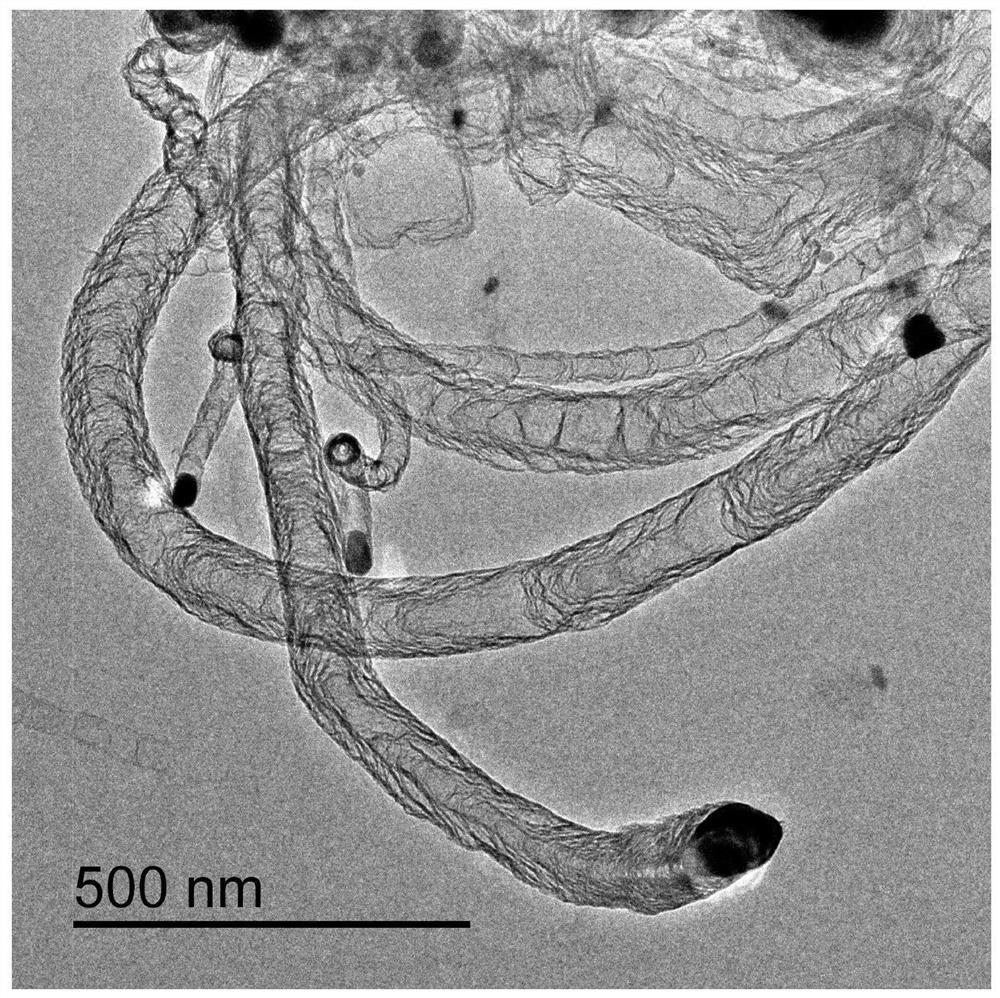Internal high-defect carbon nanotube composite material with through structure in nickel cobalt catalytic tube and application thereof
A technology of cobalt nickel oxide catalytic tube and carbon nanotube, which is applied in the direction of nanotechnology, nanotechnology, nanotechnology, etc. for materials and surface science, can solve the problems of selenium fixation difficulty, selenium difficulty, small tube diameter, etc., and achieve Excellent sodium ion storage performance, enhanced adsorption capacity, and reduced impact effects
- Summary
- Abstract
- Description
- Claims
- Application Information
AI Technical Summary
Problems solved by technology
Method used
Image
Examples
Embodiment 1
[0031] Step 1: Fully grind 0.1g of cobalt nitrate, 0.9g of nickel nitrate, and 2g of melamine in a mortar;
[0032] Step 2: Put the ground product in a quartz or alumina crucible, place the crucible in a tube furnace, and raise the temperature at a constant rate of 5°C / min under an argon atmosphere until the product is naturally heated to 700°C. The product is collected by cooling;
[0033] Step 3: Stand the obtained product in nitric acid with a concentration of 3M, corrode for 12 hours, separate the remaining solid, and dry;
[0034] Step 4: Mix the product obtained in Step 3 with selenium powder at a ratio of 2:3, place it in a reaction kettle under an argon atmosphere in a sealed glove box, heat it to 260° C. in a homogeneous reactor, and keep it warm for 12 hours to obtain CoNi@ Se / C.
Embodiment 2
[0036] Step 1: Fully grind 0.05g of cobalt nitrate, 0.95g of nickel nitrate and 2g of urea in a mortar;
[0037] Step 2: Put the ground product in a quartz or alumina crucible, place the crucible in a tube furnace, and raise the temperature at a constant rate of 10°C / min under an argon atmosphere to 600°C, and wait for the product to naturally The product is collected by cooling;
[0038] Step 3: Stand the obtained product in nitric acid with a concentration of 1M, corrode for 12 hours, separate the remaining solid, and dry;
[0039] Step 4: Mix the product obtained in Step 3 with selenium powder at a ratio of 1:4, place it in a reaction kettle under an argon atmosphere in a sealed glove box, heat it to 260° C. in a homogeneous reactor, and keep it warm for 12 hours to obtain
[0040] CoNi@Se / C.
Embodiment 3
[0042] Step 1: Fully grind 3g of cobalt nitrate, 2g of nickel nitrate, and 10g of urea in a mortar;
[0043] Step 2: Put the ground product in a quartz or alumina crucible, place the crucible in a tube furnace, and raise the temperature at a constant rate of 20°C / min under an argon atmosphere to 300°C, and wait for the product to naturally The product is collected by cooling;
[0044] Step 3: Stand the obtained product in nitric acid with a concentration of 0.5M, corrode for 12 hours, separate the remaining solid, and dry;
[0045] Step 4: Mix the product obtained in Step 3 with selenium powder at a ratio of 1:4, place it in a reaction kettle under an argon atmosphere in a sealed glove box, heat it to 260° C. in a homogeneous reactor, and keep it warm for 12 hours to obtain CoNi@ Se / C.
[0046] The sample of embodiment 1 is observed under a transmission electron microscope, from figure 1 It can be seen from the figure that the product presents bamboo-like carbon tubes with ...
PUM
 Login to View More
Login to View More Abstract
Description
Claims
Application Information
 Login to View More
Login to View More - R&D
- Intellectual Property
- Life Sciences
- Materials
- Tech Scout
- Unparalleled Data Quality
- Higher Quality Content
- 60% Fewer Hallucinations
Browse by: Latest US Patents, China's latest patents, Technical Efficacy Thesaurus, Application Domain, Technology Topic, Popular Technical Reports.
© 2025 PatSnap. All rights reserved.Legal|Privacy policy|Modern Slavery Act Transparency Statement|Sitemap|About US| Contact US: help@patsnap.com


